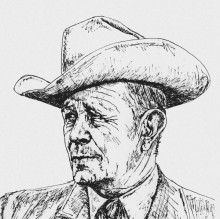
Ranching Along the Cariboo Cattle Trail
Cattle drives along the Cariboo Trail from Washington into B.C. had some extra dangers in the early days,” Alex Bulman once said.
The problem was the rivers. The Columbia had to be crossed twice, first at the Priest rapids and again at the mouth of the Okanagan River. They stayed west of Osoyoos Lake, the Okanagan River and Lake keeping to a narrow trail through clay cliffs. Then there was the Thompson River to cross near Kamloops and eventually the Fraser River heading north to the Cariboo country.
March was the best time to cross because the water was low but it was also close to freezing. It was critical to choose a place with enough beach area to prevent the herd milling back on the cattle still in the water so local Natives with canoes were hired to keep the herd swimming straight across the river. Even though trail bosses knew the safest places to cross, there were still accidents that cost both men and stock. Weak spring ice on lakes was another issue in that country even in the later years. Alex recalled when 80 steers were spooked by a dog onto a frozen lake. The ice shattered and only 20 could be rescued.
The drovers used pack horses instead of chuck wagons because of the rivers. Supplies were ferried by Native canoe and then repacked. Cowboys travelled light and were nicknamed raw hiders because they didn’t carry much more than rawhide to fix anything that broke along the way. Cattle men like Ben Snipes pioneered the drives in the 1850s and Native cowboys scouted what became known as the Cariboo Cattle trail. Many American cowboys from these drives stayed to ranch in Canada along the trail because conditions were good for increasing a herd’s size.
John Wilson and Lewis Campbell drifted a herd north from Oregon in 1864 and stayed near Kamloops. Wilson’s herd had increased to 5,000 head running on both sides of the Thompson River by 1904. Campbell ran 3,000 head on his ranch 15 miles east of Kamloops, where there is still a summer range named after him. Some cattleman came from Great Britain to develop ranches along the trail as well. Alex’s father, Joe Bulman, arrived from Newcastle, England in 1887 and by 1907 he purchased the Willow Ranch in the Kamloops area, breeding horses from his 40 broodmares and Clydesdale stallion. He married Beatrice Davie and on November 11, 1911, Alex was born.
During WW1 the Bulmans sold remount horses. The army required that remounts be only green broke so they were a little rough in battle. It was joked that remounts injured almost as many soldiers as enemy fire. The army’s need for remounts was insatiable. The Canadian Corps had 50,000 horses for the battle of Vimy Ridge alone.

Joe and his brother Tom purchased the Circle J outfit in 1917 and by the 1920s they ran over 1,000 head of cattle, 500 horses, and a small herd of mules in the Kamloops area.
Circle J was black bear country and when Alex was a young man a very large bear, judging by the size of the tracks, began killing cattle. Alex and another cowboy decided to stake out a carcass and ambush the bear from the low roof of an old cabin.
Suddenly the unmistakable shoulder hump and silver-tipped hair of a grizzly bear was heading to the bait. They had light caliber rifles but trapped on the low roof they now had to defend themselves. Using extreme caution they tracked and killed the wounded bear in the bush. It was the first and last time a grizzly wandered onto Circle J land.
The Bulmans undertook many cattle and horse drives, but several stood out in Alex’s memory. One winter the night before some horses were to be moved, the temperature dropped to -10?F and the snow started to fall. By the next morning a full-blown blizzard had set in and the wind was driving the snow hard. They decided to let the horses drift for cover while Alex and Happy Clapperton took shelter in an old cabin. They got the fire going and kept the stove red hot through the night as the temperature dropped to -40?F after the snow stopped falling. It took several days to find all the horses and they had a new respect for the ferocity of winter weather in Kamloops country.
One of the biggest buyers of Bulman horses was Harry Jamison from Ft. Worth, Tex., who would buy around 50 head at a time. After five days of hard riding in summer heat and alkali dust, they had bunched together a herd of 300 head. Jamison made his choice and then decided he wanted them trailed to Oroville, Wash., where he could load them on a train for Texas. They followed a side trail from the early days through Merritt, Princeton, Keromeos and Osoyoos to take into account the need for water and the fact that the horses were barefoot. Two Circle J cowboys, using the old rawhiders method of travelling light with a packhorse for supplies, successfully completed the Bulman‘s longest drive, a 524-kilometre round trip in three weeks without major problems.
The old methods worked just as well heading south as they had done bringing many herds north along the Cariboo Cattle Trail.
